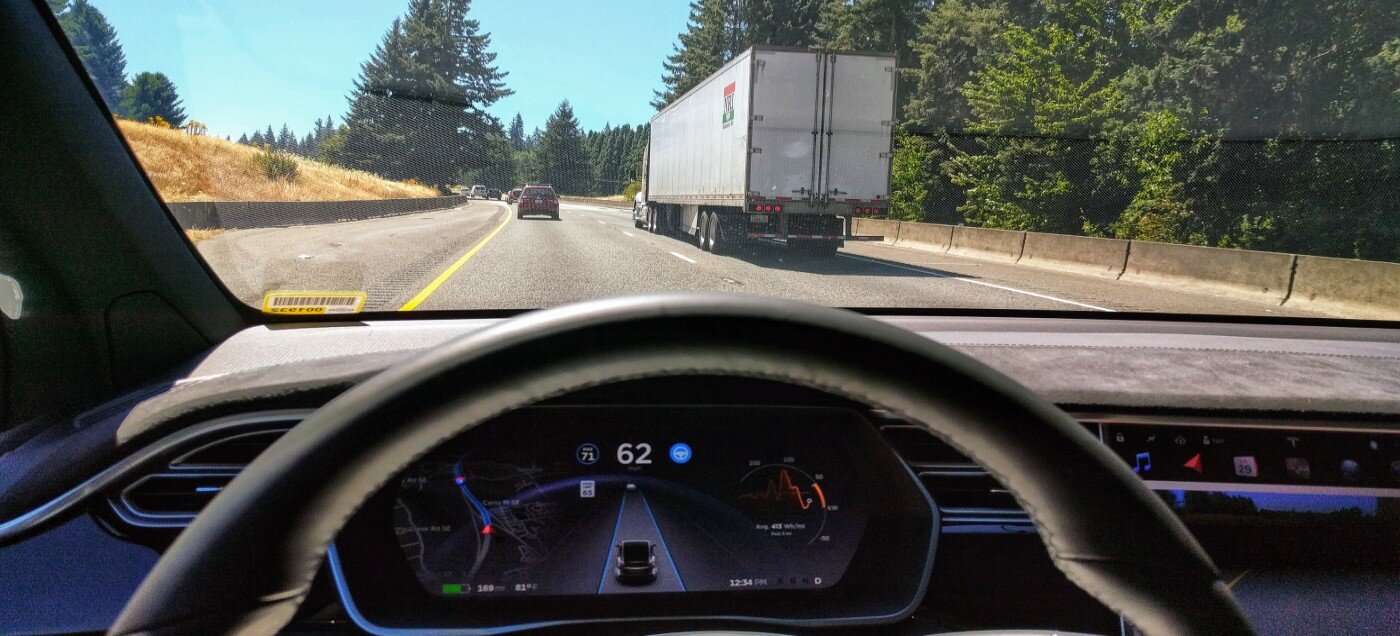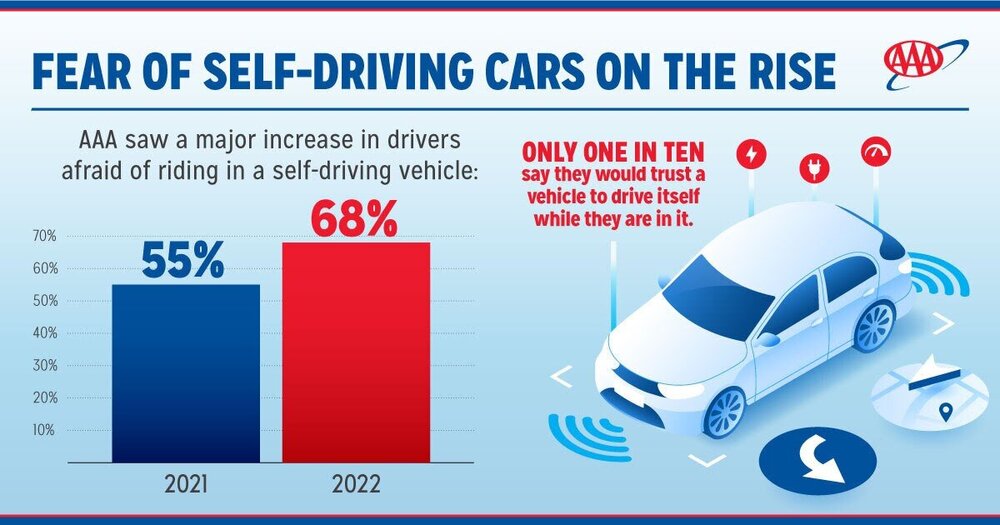Residential Real Estate News

Fear of Self-Driving Cars on the Rise as Vacation Season Nears
Residential News » Atlanta Edition | By David Barley | March 3, 2023 9:01 AM ET
According to an annual automated vehicle survey just released by AAA, concerns about self-driving cars are significantly higher than last year. The survey reveals 68% of drivers are afraid of riding in a self-driving vehicle. That's up from 55% in 2022, and the largest annual increase since 2020.
"We did not expect such a dramatic shift in consumer concerns from previous years," said Mark Jenkins, Public Relations Manager for AAA - The Auto Club Group. "Though it isn't entirely surprising, given the number of high-profile crashes that have recently occurred from over-reliance on current vehicle technologies."
Dispelling Confusion Around Automated Vehicles
Even with advancements made in recent years, these findings suggest the need to dispel confusion around automated vehicles. AAA's survey found that nearly one in ten drivers believe they can buy a vehicle that drives itself while they sleep. That is not true.
While this perception could stem from social media videos of drivers apparently misusing driver assistance technology, our survey shows that the names manufacturers have given their vehicle systems are confusing consumers. AAA found that 22% of Americans expect driver support systems, with names like Autopilot, ProPILOT, or Pilot Assist, to have the ability to drive the car by itself without any supervision, indicating a gap in consumer understanding.
"Most new vehicles are equipped with some level of advanced driver assistance technology, which can enhance the safety of motorists if used properly," Jenkins continued. "However, it's important to clarify that there are currently no vehicles available for purchase that allow someone to fully disengage from the task of driving."
What are Advanced Driver Assistance Systems (ADAS)?
Consumers are not entirely opposed to advanced vehicle technology. In fact, six in ten U.S. drivers would "definitely" or "probably" want these systems in their next car purchase.
- Examples of ADAS include blind spot warning, adaptive cruise control and automatic emergency braking. Check out AAA's, Clearing the Confusion, which provides naming and descriptions of ADAS in a consistent, easy-to-understand manner.
- Active driving assistance (ADA) combines the tasks of braking, accelerating, and steering through a combined use of adaptive cruise control and lane keeping assistance. ADA is classified as Level 2 automation - the highest level of vehicle automation available for purchase by the public. This technology is not meant to replace the driver. Recent AAA research has found inconsistencies with ADA performance, reinforcing the need for a driver to remain fully engaged.
What is a fully self-driving vehicle?
A vehicle capable of operating without human involvement. A human driver is not required to control the vehicle at any time, nor required to be present in the vehicle while moving. These vehicles are not available for purchase by consumers and are classified as Level 5 automation as defined by the Society of Automotive Engineers.
Sign Up Free | The WPJ Weekly Newsletter
Relevant real estate news.
Actionable market intelligence.
Right to your inbox every week.
Real Estate Listings Showcase
Related News Stories
Residential Real Estate Headlines
- U.S. New-Home Sales Surge in August as Mortgage Rates Ease
- Despite Increased Foreign Buyer Activity, Miami Residential Sales Dip 11 Percent in August
- California Home Sales Enjoy Modest Uptick as Mortgage Rates Ease
- U.S. Home-Flipping Profits Sink to Lowest Level Since 2008 Financial Crisis as Costs Climb
- Why the World's Rich Are Flocking to Europe in 2025
- Federal Reserve Delivers First Rate Cut of 2025 as Mortgage Relief Proves Limited
- Homebuilder Sentiment Holds Steady in U.S. as Rate-Cut Bets Lift Outlook
- U.S. Mortgage Rates Experience Sharpest Weekly Drop in Over a Year
- U.S. Foreclosures Rise for Sixth Straight Month as Affordability Pressures Mount
- Black U.S. Homeownership Rate Falls to Two-Year Low as Job Losses Mount
- Las Vegas Home Prices Flatten as Listings Surge, Sales Slow
- Cooling Miami Housing Market Sees 16 Percent Annual Sales Drop in July
- U.S. Mortgage Delinquencies Uptick in June Amid Regional Pressures
- California, Florida Top U.S. Housing Markets Most at Risk of Downturn
- 30-Year Mortgage Drops to 6.56 Percent in Late August, Lowest Since October 2024
- Investors Maintain Elevated Role in U.S. Housing Market Despite Slight Pullback
- Pending Home Sales Show Mixed Signals as U.S. Buyers Remain Cautious
- Canadian Home Sales Extend Recovery in July
- U.S. Home Sales Rise in July as Buyers Gain More Bargaining Power
- Zombie Foreclosures Edge Up Across U.S.
- 2.6 Million Homes at Wildfire Risk Across 14 Western States in 2025
- One in Five Americans Willing to Trade Personal Safety for Home Affordability
- U.S. Home Price Growth Slows as Affordability Pressures Mount in 2025
- U.S. Mortgage Rates Dip to Four Month Low in Early August
- U.S. Mortgage Applications Rise in Late July, Breaking Four-Week Slump
- Hong Kong's Housing Market Stuck in Stalemate as Bulls and Bears Face Off
- U.S. Condo Market Struggles in 2025
- U.S. Pending Home Sales Remain Sluggish in June
- Los Angeles Area Wildfires Destroyed Nearly $52 Billion in Homes Last January
- Greater Palm Beach Area Residential Sales Slip in June Amid Growing Inventory
- Economic Resilience Lifts U.S. Housing Outlook Going Forward
- New Home Sales Stagnate as Affordability Struggles Continue in America
- U.S. Housing Market Slips in June as Prices Hit New Highs
- Florida, California Continue to Reign Supreme as America's Ultraluxury Housing Markets
- Caribbean Housing Market Evolves into Global Second-Home Hotspot
- U.S. Home Sales See Highest June Cancellation Rate on Record
- Orlando Housing Market Cools in June as Listings Slide, Sales Slow
- Private Credit Surges in 2025 as Real Estate Developers Bypass Banks
- U.S. Condo Market Suffers Sharpest Price Drops in Over a Decade as Buyers Retreat
- Rising Taxes, Insurance Costs Undermine the Stability of U.S. Homeownership








